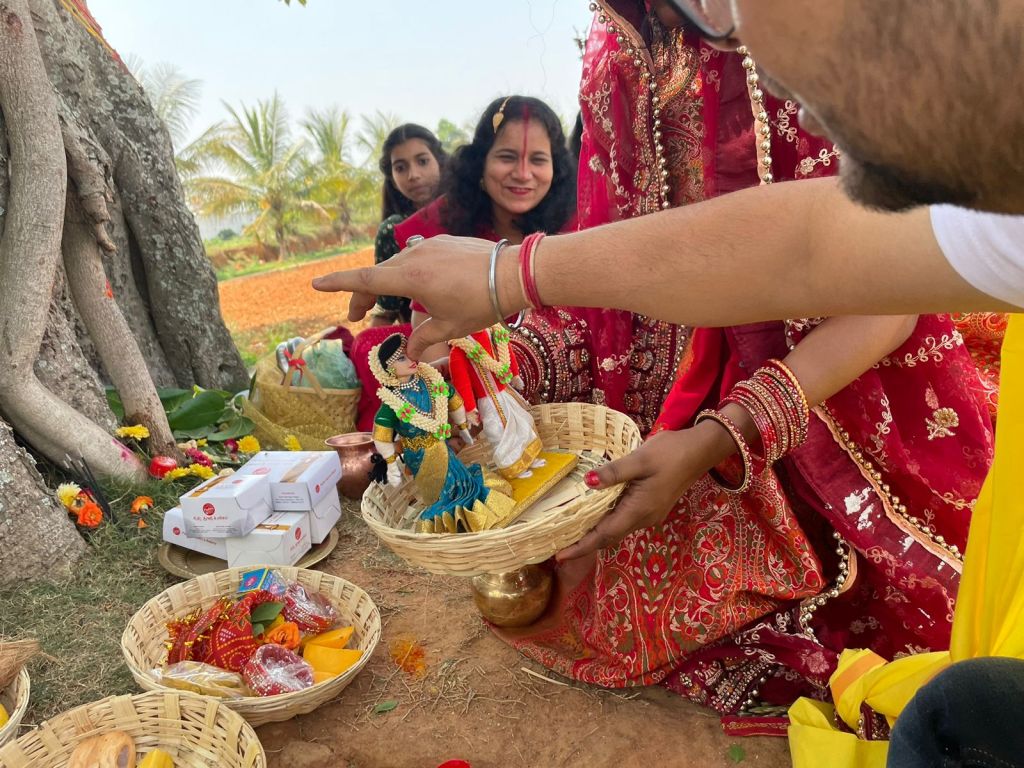Vat Savitri Vrat is observed on the Amavasya (New Moon Day) of Vaishaka Month every year. The festival is primarily observed by Hindu ladies for Longetivity and Prosperity of their Husbands by observing fasts and offering prayers to Vata Vriksha (Banyan Tree or Aalada Mara in Kannada). The legend is based on the story of Savitri and Satyavan and how determination of Savitri defeated God of Death Yama to save her husband Satyavan who was destined to die.
Importance of Vata Vriksha or Banyan Tree
Banyan tree (Ficus benghalensis), is considered immortal and it can be seen that as it grows it develops aerial roots and as it touches the earth takes root there and this is how it gets propagated perpetually rendering it immortal. Reason why it is greatly revered since the Vedic times. Vata Vriksha also symbolizes strength, standing firm possessing all desired virtues and virility. It is also called as ‘Iccha Vriksha’ or ‘Tree that grants wishes’. It is also pertinent here to note that the tree has rich medicinal value and various drugs are prepared from various parts of the tree.
There is another school of thought that believes that Trimurti of Brahma, Vishnu and Shiva reside in Vat Vriksha. It is believed that Lord Vishnu is present in the bark of the Banyan tree, Lord Brahma is present in the roots of the Banyan tree and Lord Shiva is present in the branches of the Banyan tree. Thus it is considered a symbol of life and fertility
Legend of Savitri and Satyavan
The legend can be traced back to days of Mahabharata, Savitri was born after severe penance and prayers by childless King Ashwapati and his wife Malavi. Sun Deity Savitr appears and blesses them with a daughter who was named Savitri. She was so beautiful and pure to a degree that would intimidate any man from asking for her hand in marriage and after lot of efforts parents give up and asks her to find her own husband.
She sets out to find a husband and during the course of a pilgrimage finds Satyavan, son of a blind king Dyumatsena, who lost his Kingdom to treachery and was living in exile in a forest. She falls in love with handsome Satyavan and decides he will be her husband. She returns back to find Narada Muni in serious conversation with her father King Ashwapati. Narada Muni with his foresight already knew her choice and also what was in store for her in this marriage. He dissuades her from this marriage saying it is a bad choice and warning her that Satyavan’s life span is very limted and destined to die in exactly 1 year from the date of marriage. But Savitri was adamant and goes ahead with the marriage with great pomp and splendour.
3 days before the predicted death of Satyavan, Savitri begins observing a vrata (vow or penance) of fasting. The vrata was so severe that even Satyavan’s father requests her to temper it down, but she refused to do so. As destined on the day of foreseen death while he was chopping wooden logs, Satyavan feels weak and breathes his last on Savitri’s lap.
She lays the lifeless body of Satyavan under Vata Vriksha and feels devastated. When God of Death, Yama comes to take his soul away, Savitri follows him and continously prays and pleads for his life. Yama offers her anything she needs except life of Satyavan. Intelligent that Savitri was first seeks to restore eyesight and the lost kingdom of King Dyumatsena. She then seeks a hundred children for her father, King Ashwapati and then finally, a hundred children for herself and Satyavan. Yama had no choice but to return life of Satyavan which he does in the form of Kadalekaalu (Chick pea or Chana) and blesses her.
Vata Savitri Vrata is thus observed to commemorate triumph of Truthful and Sincere Determination over Destiny. As in any festival, Sanatana Dharma reveres everything in the creation, the animate and the inanimate and this festival is no different. The Vata Vriksha is the objective of worship in this case, importance of the tree is already explained before.
Vrata Vidhana
Puja Samagris
- Red Kalava or Mauli or Sutra
- Bamboo whisk
- Leaves of banyan tree
- Red cloth, saffron or red color to keep in puja
- Incense, lamp and flowers
- fruit
- Kalasha Paatra (Vessel) filled with water
- Items used by Sumangalis
- Channa (Chick Peas)
- Murti of Couple (Dolls decked in maarriage attire)
Vrata Vidhi
- Women observing this Vrat wake up before sunrise and have their bath.
- Wear new clothes, bangles, Kumkum (vermilion) on the forehead.
- Visit a Vata Vriksha (Banyan Tree) and offer water to the root of the banyan tree.
- Jaggery, Chana/Kadalekayi (Chick Peas), fruits, akshata and flowers should be offered as Naivedya
- Thereafter women make a pradakshina (Circambulation) around the banyan tree wrapping it with thread (Yellow and Red) called Roli circumambulation by wrapping yellow or red thread around the banyan tree.
- Continue to sincerely pray for good luck and long life of the husband while doing pradakshina.
- Seek blessings from the elders of the house and married women.
Daana performed on Vata Savitri Vrat is considered very fruitful. Perform charity by donating money, food and clothes to the poor and needy according to their ability.
Om Savitryayi Namaha
Sharing pictures of Vat Savitri Vrath as observed by my Manasik daughter, Swatishree who is married to Rajvardhan Jha and it was her first Vrat and observed the way a Newly Wed Maithili Brahmin has to perform.














